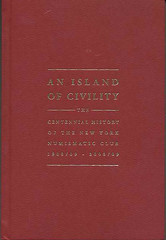
About UsThe Numismatic Bibliomania Society is a non-profit organization promoting numismatic literature. For more information please see our web site at coinbooks.org SubscriptionsThose wishing to become new E-Sylum subscribers (or wishing to Unsubscribe) can go to the following web page link MembershipThere is a membership application available on the web site Membership Application To join, print the application and return it with your check to the address printed on the application. Membership is only $15 to addresses in the U.S., $20 for First Class mail, and $25 elsewhere. For those without web access, write to: David M. Sundman, Secretary/TreasurerNumismatic Bibliomania
Society AsylumFor Asylum mailing address changes and other membership questions, contact David at this email address: dsundman@LittletonCoin.com SubmissionsTo submit items for publication in The E-Sylum, just Reply to this message, or write to the Editor at this address: whomren@coinlibrary.com
BUY THE BOOK BEFORE THE COINYou won't regret it! |
- WAYNE'S WORDS: THE E-SYLUM JANUARY 24, 2010
- DIX NOONAN WEBB TO OFFER GRIFFITHS LIBRARY OF TOKEN LITERATURE
- CONDER TOKEN DIGITAL QUICK REFERENCE BEING REVISED
- 2010 JEAN ELSEN NUMISMATIC LITERATURE FIXED PRICE LIST AVAILABLE
- LAKE BOOKS SALE #101 PRICES REALIZED PUBLISHED
- NEW YORK NUMISMATIC CLUB CENTENNIAL HISTORY PUBLISHED
- BOOK REVIEW: THE CHEAT IN YOUR CHANGE
- BOOK REVIEW: THE PAPER REPUBLIC (OF TEXAS) BY JAMES BEVILL
- HARVEY STACK ON THE STACK FAMILY NUMISMATIC LIBRARY SALE
- EUROPEAN NUMISMATIC NETWORK RESEARCH PROPOSAL
- MORE ON MEDAL MAKERS NOBLE & BENTON
- MORE ON THE COMITIA AMERICANA MEDALS
- QUERY: REEDED EDGE IRA REED NICKELS
- SMITHSONIAN ACQUIRES USDA FOOD STAMP ARCHIVE
- SECOND BRITISH AMERICAN TOKEN CONGRESS, CHARLOTTESVILLE VA
- THE SPENDING PSYCHOLOGY OF COIN AND PAPER MONEY DENOMINATIONS
- VESPASIAN'S JUDEA CAPTA DENARIUS
- 1910 CELTIC FOOTBALL CLUB MEDAL DISCUSSED ON TV ANTIQUE SHOW
- SUPER BOWL COIN TOSS TO USE NASA SPACE VETERAN MEDAL
- FEATURED WEB PAGE: J. S. BACH MEDALS, MEDALLIONS & COINS
WAYNE'S WORDS: THE E-SYLUM JANUARY 24, 2010

Among our new subscribers this week is Rex Borders, courtesy of Warner Talso. Welcome aboard! We now have 1,311 subscribers.
We had no takers for Pete Smith's quiz question. Can anyone tell us about the painting at the Museum of Modern Art which has one cent coins embedded in the paint?
This week we have reports on several numismatic literature fronts, including new literature fixed price lists and upcoming auctions from around the world. A new history of the New York Numismatic Club has been published, and I review Jim Bevill's new book on Texas numismatic history and a field guide to detecting counterfeit one pound coins.
In other topics, Harvey Stack recounts the recent Kolbe sale of highlights from the Stack Family Numismatic Library, readers chime in on Comitia Americana medals, medal makers Noble & Benton, and Ira Reed's "reeded" nickels.
In the news, the National Numismatic Collection makes a major acquisition, and a new report studies the spending psychology of money denominations. To learn about topics as diverse as Vespasian's Judea Capta denarius and the coin toss at next month's Super Bowl, read on.
Wayne Homren
Numismatic Bibliomania Society
DIX NOONAN WEBB TO OFFER GRIFFITHS LIBRARY OF TOKEN LITERATURE
 For now though, suffice to say that it is the best such private library of Conder and other token-related books and publications ever formed. The owner, who lives in Hertfordshire, England, began his quest in the mid 1970s and was able to secure many fine volumes at that time.
For now though, suffice to say that it is the best such private library of Conder and other token-related books and publications ever formed. The owner, who lives in Hertfordshire, England, began his quest in the mid 1970s and was able to secure many fine volumes at that time.
He has constantly sought to upgrade and add to the library ever since and has a number of books once owned by the likes of Samuel Hamer, Richard Dalton, Arthur Waters, William Davis and others from the early 20th century. Every book in the library is provenanced.
As an aside, I was also among those crammed into the room at the Waldorf-Astoria for the sale of the Stack's library. Even though I only secured one lot it wasn't for lack of trying! To my mind it was the most notable of all the plethora of auctions that annually saturate the New York International show.
To visit the Dix Noonan Webb website, see: www.dnw.co.uk
CONDER TOKEN DIGITAL QUICK REFERENCE BEING REVISED

What's in it for the Novice? Everything ! It's more than an extremely cost-effective alternative to buying a hard copy of D&H. It provides all of the essential content of D&H and the need-to-know facts about the original reference. Incorporates a discussion on rarity, token composition analysis, collecting tips, value study, and an excellent article on the history of the series courtesy of Professor George Selgin.
What's in it for the Connoisseur? A lot ! Everything has been completely integrated and reformatted. Unique search-ability and tons of intra-document links make sifting through the hundreds of pages in D&H nearly effortless…and includes a price analysis to boot!
- Statistical Price Analysis
- Streamlined Content and Vastly Improved Organization
- Instant Token Search
- Graphically Organized Click Index
- Fully Illustrated with Thousands of Colourised Images
- Fully Printable
- Zoom-able
For more information, see: condertokenbook.com
2010 JEAN ELSEN NUMISMATIC LITERATURE FIXED PRICE LIST AVAILABLE
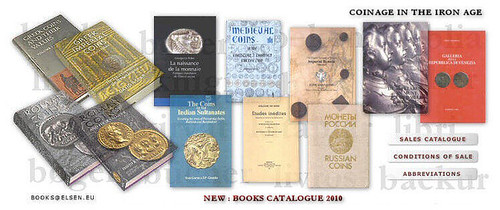
To view the complete catalogue, see: www.elsen.eu/index.aspx?tabindex=4&tabid=57
LAKE BOOKS SALE #101 PRICES REALIZED PUBLISHED
Fred Lake of Lake Books writes:
The prices realized list for our sale #101 which closed on January 19, 2010, is now available for viewing on our web site at www.lakebooks.com/current . You will also find it at our "Past Sales" page in both PDF and Word formats.
The sale featured reference material from the library of Fred Iskra and bidding was very active, particularly for a run of early sales from Presidential Coin and Antique. Other areas of interest included numismatic literature dealer emissions and Early American Coppers sales.
Lake Books next sale will be held in late March or early April and will feature an extensive selection of choice "Redbooks" and "Bluebooks" from the estate of Nicholas Boccuzzi.
NEW YORK NUMISMATIC CLUB CENTENNIAL HISTORY PUBLISHED
While I was at the NYINC I was able to pick up my copy of the New York Numismatic Club's Centennial History and medal. The book's title is "An Island of Civility - The Centennial History of the New York Numismatic Club 1908/09 - 2008/09". It has 437 numbered pages, and is limited to 125 copies. The Club history is authored by John Kleeberg, and the club medal section by David T. Alexander.
The medal is by Eugene Daub and struck in a very limited number in silver and bronze. The medal features on the obverse the Liberty head from Saunt-Gaudens' Sherman monument, and the reverse a montage of J. Sanford Saltus and Edward Newell looking at a coin while Henry Grunthal looks at the Liberty Statue.


THE BOOK BAZARRE
BOOK REVIEW: THE CHEAT IN YOUR CHANGE
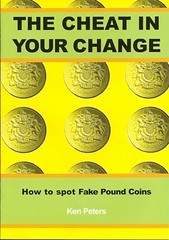 Author Ken Peters sent me a copy of his 2005 book, The Cheat In Your Change, which is a field guide for determining fake from genuine British one pound coins.
Author Ken Peters sent me a copy of his 2005 book, The Cheat In Your Change, which is a field guide for determining fake from genuine British one pound coins.
I have a lot of personal interest in the Cheat in Your Change booklet. When I lived in London in 2007 I often wondered how many of the pound coins I used were counterfeit. They all seem so worn I guessed it would be easy to circulate counterfeits, and I turned out to be right.
Here's some text from the start of the booklet (thanks, Ken!):
Since the first pound coin of 1983, three different portraits of the Queen have appeared, plus five different edge markings and twelve different reverse designs. This is not something that forgers seem to be aware of or particularly bothered about, resulting in thousands of fakes being made with wrong pairings of date, bust, reverse design or edge legend.
HOW TO SPOT FAKE POUND COINS
Is there any glint of silver apparent anywhere? This is the fatal weakness of all lead alloy fakes, that once cast, have to be coated to match as nearly as possible the gold colour of a genuine coin. This type of fake does not have to be in circulation for long before wear, accidental or deliberate damage break through the thin surface coating.
There are three main types of forgery. The lead (sometimes tin) alloy efforts just mentioned, nicknamed by the Royal Mint "garden shed" fakes, because that is where many small-scale 'enterprises' have been located. The second type - hard metal nickel-brass. The third type has a lead core in a thick 'crust' of hard metal, one source of which turns out to be melted down genuine coins.
The 8 1/4" x 6" softcovered booklet has 24 pages, counting the covers. The content is divided into 18 concise chapters, starting with the basics: Colour Comparisons, Basic Checking, Edge Checking and Die Axis Deviations. Other tells include Ring (the sound the coin makes when dropped on a hard surface), Touch and even Smell. A section titled "Odd But OK" describes certain genuine and acceptable pound coins that are seldom seen in mainland Britain. While they may look odd to most people, the pound coins issued for use in the Falklands, Gibraltar, Guernsey, Isle of Man, Jersey and St. Helena are all good.
Another section details the specifications of genuine Royal Mint one pound coins. My favorite section is the two-page Quick Check photo spread at the center of the booklet. The guide is a handy one-stop reference to the proper combinations of queen's head, reverse design and edge legend for genuine coins.
I didn't realize such a book existed or I would have endeavored to pick up a copy in 2007 - it would have been fun to examine my pocket change with the guidebook in hand. I supposed one could assemble quite a collection of different varieties of circulating counterfeits.
For more information or to obtain a copy of the booklet, contact author Ken Peters at kenvoy@hotmail.co.uk.
BOOK REVIEW: THE PAPER REPUBLIC (OF TEXAS) BY JAMES BEVILL
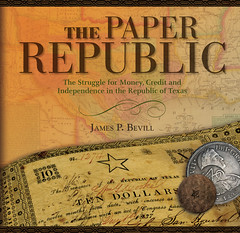 A large package arrived earlier this week. In a familiar ritual, my wife asked, "What did you buy NOW?" My response is typically predicated on how the item LOOKS. If it's small and cheap looking, I'll say, "Oh, it's a little pamphlet I bought for my library." If it looks big and expensive, I'll say, "I think somebody sent me a review copy."
A large package arrived earlier this week. In a familiar ritual, my wife asked, "What did you buy NOW?" My response is typically predicated on how the item LOOKS. If it's small and cheap looking, I'll say, "Oh, it's a little pamphlet I bought for my library." If it looks big and expensive, I'll say, "I think somebody sent me a review copy."
Well, this box was hefty, so I said it was a review copy. When I opened the box I just said "Wow!" It was James Bevill's new book, The Paper Republic, The Struggle for Money, Credit and Independence in the Republic of Texas. Larger than I'd imagined, the massive 354-page hardcover book is coffee-table sized at nearly 11" x 11". It has a color pictorial cover PLUS a glossy color dust jacket.
First, it's much more than just a coin or paper money book. It is very much a history book, but one illustrated throughout with images of numismatic items - primarily paper, but also coins. I made a beeline to the section on the New Spain Jolas of 1817-1818, and I wasn't disappointed. Eight different specimens were illustrated in color, obverse and reverse, in a four-page section in chapter two.
The book has a four-page Bibliography and a seven-page Index - remember, these are BIG Texas-sized pages. But that's not all - each chapter has a page of fine-print endnotes, typically forty in number, nearly eighty in some chapters.
Is it a catalogue of Texas numismatic issues? No - you won't find a checklist of all known types and varieties of paper financial instruments, but there are other books that serve those needs. What Bevill's book does is clearly lay out the historical and financial background of all the major issues, with all the good intentions (and bad) of the people responsible for their issue. On p220 for example, is a section titled "A Revolving Door of Deception", about secretly issued 1840 promissory notes.
From p322:
From the standpoint of numismatists, it is interesting to note that the money of the Republic of Texas is among the scarcest of collectible paper money. The exchequer bills are extremely rare because they were destroyed by the government upon their redemption to prevent their reissue.
From p324:
Fortunately for collectors and historians of today, there were several thousand pieces of the obsolete money stored in various county depositories.... Many state and county officials, including judges and at least one state treasurer, helped themselves to the old bills from the archives and storage rooms of their respective facilities and discretely sold them for collectors.
There are many great anecdotes and interesting stories throughout this beautifully arranged book. I highly recommend it to U.S. numismatists and anyone interested in the history of the state of Texas, numismatist or not. It's a great read. This isn't a book to be sat on the shelf just for reference - it's one that should be savored page by page. Congratulations to Mr. Bevill for his accomplishment; every state deserves to have such a book written, but few have been as blessed as Texas.
To read the earlier E-Sylum, see: NEW BOOK: THE PAPER REPUBLIC (OF TEXAS) BY JAMES BEVILL (www.coinbooks.org/esylum_v13n02a03.html)
HARVEY STACK ON THE STACK FAMILY NUMISMATIC LIBRARY SALE
"I think it gives another perspective to 'Get the book before the coin (and use it after you get it)'
The comments at the sale were great, the results were super, and the appreciation of what we had was so rewarding to hear from those who I spoke to. It was a separation from something I and the family lived with, and I know those who acquired the books had the same appreciation for the library."
Now that the first part of the STACK FAMILY LIBRARY has been sold I feel that I should write to you and tell you how pleased my family and I are with the catalog prepared by George F. Kolbe for the Public Auction on January 9, 2010.
The catalog was a MASTERPIECE. Not only did it offer some of the great highlights of the Stack Family Library, giving each lot a full description and commenting on its importance to numismatics, but it also traced the history of Stacks from the Depression Years to the present day through its PRIZE WINNING CATALOGS and LIBRARY.
George invited a group of collectors, dealers and a chief librarian, to comment on the Library, and how it reflected on Stack's dedication to the Hobby of Numismatics and the collecting environment during the last eight decades. He published their writings in the auction catalog, providing great insight as to how they and the Stack Family and their staff used the library and files.
Those who wrote included William (Bill) Anton, a great collector; Michael Hodder, super researcher and author; John Dannreuther, a professional numismatist; Frank Campbell, the famous ANS Librarian; numismatic researcher and bibliophile P. Scott Rubin; and, of course, George F. Kolbe, the greatest numismatic book cataloguer and myself.
The story of William Anton, Jr., of his father and his experiences, begins when he first visited Stack's during the late 1940s. Both were always treated both as friends and great numismatists. They were early members of the STACK'S CLUBHOUSE. Stack's offered numismatists a meeting place on Saturdays throughout the year, where collectors could gather, talk numismatics, use our library, and buy, trade, or sell numismatic items.
We provided a warm, wood-paneled showroom, with sit-down counters, and lots of spots for private discussions. Much information was freely exchanged and those who came learned from each other. All of the famous collectors and dealers visited from time to time, and we all benefited from these scholarly chats. I, for one, received some great training and was able to participate in the discussions.
Michael Hodder, who joined Stack's in the 1980s as a cataloger and researcher, wrote about his friendship with the Stacks and how catalogs were conceived and brought to fruition. Mike's last major project was to be the lead cataloguer for the famous and greatest collection ever sold at auction. Ultimately, twenty-one catalogues were entirely devoted to the John J. Ford, Jr. Collection, a prize-winning accomplishment.
Frank Campbell, the former Chief Librarian of the American Numismatic Society, wrote about the books we published, and how he as well as others used them, also the importance of a WORKING LIBRARY in the hands of the professional dealer and auctioneer—an immeasurable aid in making their catalogs authoritative and interesting.
John Dannreuther authored an interesting and humorous narrative about the INNER SANCTUM, the office in the back portion of our shop where Norman Stack, my cousin, and I shared a Partners Desk for decades, surrounded by floor-to-ceiling book shelves containing portions of the "working library."
P. Scott Rubin wrote about early numismatics in New York, its dealers and collectors, and the catalogs that Stacks produced from 1935 to the present century, some 800 different sales catalogs in all. Scott also discussed how the Stack family influenced the way numismatic business was done and the dignity they tried to project on the industry and hobby.
George F. Kolbe unquestionably produced the best NUMISMATIC BOOK CATALOG one could hope to have. He is extremely knowledgeable, dedicated to his work, knows how to describe books in the context of their importance, and enhances his catalogs with numerous illustrations, resulting in a marvelous catalog to offer the items he has for sale. He contacted many potential buyers, prepared advertising and press releases to develop interest in the sale, and so much more.
The end result: an AWARD WINNING CATALOG!
My part in the catalogue was to prepare the Family Tree so that everyone would know one Stack from another; to get photos of the family to go with the narratives; to check some of the information, mostly from my memory; to add to the descriptions; and to do any other work George needed done.
It was an exciting though somewhat sorrowful experience, parting with Old Friends (books I used and loved). It is also gratifying to know that the purchasers would use the information in the library to enhance their knowledge and the fun and excitement of numismatics—by learning from THE PAST TO ENHANCE THE FUTURE.
- Sale 112: April 29, 2010
- Sale 113 (Stack Family Library Part II): June 3, 2010
- Sale 114: September 16, 2010
To read the earlier E-Sylum article, see: KOLBE 111TH SALE RESULTS: STACK FAMILY LIBRARY & ANS DUPLICATES (www.coinbooks.org/esylum_v13n03a03.html)
EUROPEAN NUMISMATIC NETWORK RESEARCH PROPOSAL
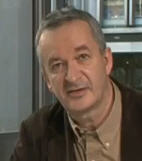 Georges Depeyrot of the Centre de Recherches Historiques in Paris writes:
Georges Depeyrot of the Centre de Recherches Historiques in Paris writes:
We are now finishing an application for a European numismatic network on European monetary unification, from antiquity to modern times (EMU). You will find a short video presentation of the project in the link below.
From "an excellent Mexican restaurant in Amsterdam", Georges writes:
The volume is a coin changer book printed in Anwerpen during the 17th century. I put a .pdf of it on the Moneta web site. Go to moneta.be, then e-papers, then "monnaies modernes", then the volume is Carte Verdussen.
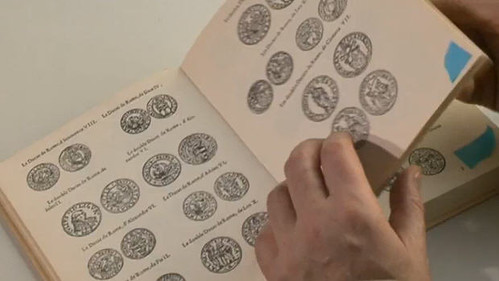
To view the complete video, see: COST application on Monetary Unifications (www.youtube.com/watch?v=O1EOr1mT_Kc)
For more information (in French) on the Centre de Recherches Historiques, see crh.ehess.fr
THE BOOK BAZARRE
MORE ON MEDAL MAKERS NOBLE & BENTON
Regarding Kay O. Freeman's query about medal makers Noble & Benton, David Gladfelter writes:
Groce & Wallace list a Charles F. Noble, engraver, working in Philadelphia 1850 and after, with Scattergood & Noble in 1859 and Noble & Nagle in 1860 and later. No mention of Noble & Benton, or Benton, however. No entries for Noble & Benton either in NYC directory of 1850-51 (New York has an Exchange Place). A James Noble, coiner, is listed in 1852 Philadelphia directory but not Noble & Benton. Sometimes it's helpful to know of an absence of information and that's what I have.
I asked David for more information on the Groce & Wallace reference. He writes:
George C. Groce and David H. Wallace, The New-York Historical Society's Dictionary of Artists in America, 1564-1860 (New Haven, Yale University Press, 1957). It's a better source for American engravers and die sinkers than Forrer's eight-volume Biographical Dictionary of Medalists (or "BDM" for short). I looked there too, but nothing. Nada. Zip.
To read the earlier E-Sylum article, see: QUERY: MEDAL MAKERS NOBLE & BENTON (www.coinbooks.org/esylum_v13n03a12.html)
MORE ON THE COMITIA AMERICANA MEDALS
John W. Adams, author of Comitia Americana and Related Medals writes:
Last week's E-Sylum contained an extract on the Washington Before Boston medal, the original article having been composed by the Special Collections staff at Notre Dame. Despite such illustrious authorship, the piece contains two major mistakes.
First, the COMITIA AMERICANA medals were not first made in 1790; indeed all except the one struck for John Paul Jones were made earlier, including Fleury (1780), Gates (1787), Greene (1787) and the others save for Jones in 1789.
A more curious mistake concerns the restrikes which were said by Notre Dame to have been made in gold as well as other metals. I have long suspected that Colonel Fleury cozened either Franklin or Du Vivier into striking an unauthorized example in gold but, otherwise, the use of that metal was limited strictly to specimens specifically awarded by Congress.
Franklin (in the case of Fleury) and Jefferson (in the case of Jones) are on record as stating the limits to their authority. Ironically, the U.S. Government was later to break its own rules when, after the French had transferred the original dies in 1939, it used the occasion of the 200th anniversary of Jones' birth in 1947 to make a gold medal replacing Jones' medal which had been lost AND two others.
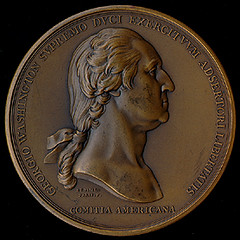
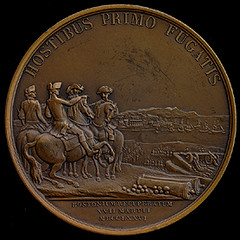
R.W. Julian writes:
"I saw the note about mint medals that derived from the Notre Dame website. It will perhaps be of interest to readers of The E-Sylum that the Paris Mint did not furnish hubs or punches as stated on that website. In point of fact Director James Pollock ordered certain of the Revolutionary War medals from the Paris Mint and some of these were used to make dies at the Philadelphia Mint."
To read the earlier E-Sylum article, see: FEATURED WEB PAGE: WASHINGTON BEFORE BOSTON MEDAL (www.coinbooks.org/esylum_v13n03a18.html)
QUERY: REEDED EDGE IRA REED NICKELS
Web site visitor Walter Sansone writes:
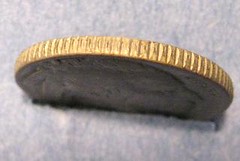 I just recently bought a 1937 reeded nickel, which I believe is an Ira Reed nickel of the 1940's. I ran across an article on the Internet that appeared in your newsletter a while back. I am looking for a picture of an example of a confirmed Ira nickel - does anyone know where I could find one of these? I would like to find out how many reeds are on the nickel, and how thick they might be. I attached pictures for advice, thanks for your time.
I just recently bought a 1937 reeded nickel, which I believe is an Ira Reed nickel of the 1940's. I ran across an article on the Internet that appeared in your newsletter a while back. I am looking for a picture of an example of a confirmed Ira nickel - does anyone know where I could find one of these? I would like to find out how many reeds are on the nickel, and how thick they might be. I attached pictures for advice, thanks for your time.
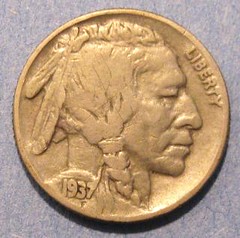
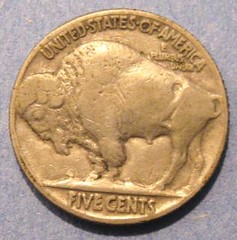
Dave Lange writes:
"An example of Reed's reeded nickel is illustrated on page 56 of my book, "The Complete Guide to Buffalo Nickels", Second Edition. The edge is clearly visible.
I've seen a number of these coins, and I've noticed that the reeding is not always the same. A few have much finer reeding than on the example illustrated. This suggests to me that additional pieces have been made to sell as novelties. For that reason, I don't advocate paying a significant premium for any example that isn't traceable back to the 1941 ANA Convention. Even then, its value is based on its memorabilia interest. Such coins have no numismatic value.
The piece illustrated in my book is, I believe, one of the 1941 originals and has rather broad reeding. In case anyone didn't get it, Reed had these coins REEDed as a play on his name."
To read the earlier E-Sylum articles, see:
REED'S REEDED NICKELS
(www.coinbooks.org/esylum_v05n13a09.html)
REEDED CENTS
(www.coinbooks.org/esylum_v05n14a08.html)
THE BOOK BAZARRE
SMITHSONIAN ACQUIRES USDA FOOD STAMP ARCHIVE
 Like a $10 bill, it was printed by the Treasury, and it bore proud emblems of American democracy — an eagle, a portrait of Alexander Hamilton — alongside the words "10 Dollars." Unlike ordinary currency, though, it also bore a warning: "Nontransferable except under conditions prescribed by the secretary of agriculture."
Like a $10 bill, it was printed by the Treasury, and it bore proud emblems of American democracy — an eagle, a portrait of Alexander Hamilton — alongside the words "10 Dollars." Unlike ordinary currency, though, it also bore a warning: "Nontransferable except under conditions prescribed by the secretary of agriculture."
Although the government distributed billions of these food coupons, or food stamps, over the last half-century, only a small number have survived since they were replaced by a debit-card-like system. Now this coupon — and the master dye used to make the plate that created it — will be enshrined in the Smithsonian's National Museum of American History, which on Thursday announced that it has acquired a large trove of materials related to the food-stamp program.
The materials, long housed at the Agriculture Department, which runs the program, were headed for disposal until last summer, when two museum volunteers alerted curators and helped arrange for the most significant items — nearly 200 in all — to be transferred and preserved. The items include food coupons, booklets, proof sheets, early artists' designs and printer's plates.
"What we did, effectively, was go over and cherry-pick the collection," Richard Doty, senior curator of the National Numismatic Collection at the museum, said on Thursday. "We wanted to tell a story with it."
The museum's director, Brent D. Glass, said the acquisition was "especially significant considering the current economic hardships facing Americans today."
Michael B. Katz, a historian at the University of Pennsylvania and an authority on welfare and social policy, applauded the acquisition. "It shows an attention to the history of social policy, which is an important part of the history of this country that is relatively neglected by that museum," he said.
Others took a dimmer view. "A roomful of material relating to food stamps is another example of why museums aren't much fun anymore," said Charles Murray, a conservative scholar at the American Enterprise Institute who believes that welfare programs promote dependency. "I get chills when I go to a great museum and see Jefferson's writing desk or the coat Nelson was wearing at Trafalgar," he added, whereas an acquisition like this amounts to little more than political correctness. ("It's spinach, and it's good for us," Mr. Murray said. "I say to hell with it.")
Putting it more directly (and I have his OK to publish this), Dick Doty adds:
I say to hell with Mr. Murray!
SECOND BRITISH AMERICAN TOKEN CONGRESS, CHARLOTTESVILLE VA
Following the great success of the First British-American token Congress held in Seattle, we are happy to announce that the Second British-American token Congress will be held in Charlottesville, Virginia in May 13-15 of 2010.
As with the previous British token Congresses, this is a great opportunity for fellow collectors to meet like minded friends to share talks, food, a bourse and most importantly, the great hobby we all share.
This time the host city is Charlottesville, located at the foothills of the Blue Ridge Mountains in the Commonwealth of Virginia. Charlottesville has a lot to offer drawing millions of visitors to Monticello, home of Thomas Jefferson, Ashlawn-Highlands, home of James Monroe, and Montpelier, home of James Madison. There are dozens of vineyards within easy reach. Forty-five minutes to the west in Staunton is the American Shakespeare Theatre that performs Shakespeare's works under their original staging conditions. A little further out is Mount Vernon, Jamestown, Yorktown and Williamsburg. And, for Civil War buffs – there is no end of battlefields and places of interest – including Petersburg and Appomattox.
The venue for the Congress will be at the Omni Hotel in Charlottesville, Virginia. Similar to the previous Congress, we will start with an opening and a dinner reception on Thursday May 14th. Friday will be a full day of talks and token lore, meals and breaks, and a round table discussion. Saturday will be the second full day of talks, including breaks, a second round table discussion, and followed by a Saturday night bourse which is open to all attendees. Tables for dealers and collectors are included in the cost of the Congress. The last day will be Sunday, which will start with breakfast and talks, planning to end around lunch time - leaving enough time for people who might want to go for a Monticello tour.
Here are the details needed to sign up:
Dates: May 13-15, 2010
Location: The Omni Hotel in Charlottesville, Virginia
Cost: The Congress and all talks, reception dinner, meals and bourse is $395 for the event.
We have reserved rooms at the Omni at a discounted rate of $198.69 per night including tax. You will be responsible for making your own reservations. The OMNI Hotel has a dedicated website for registering - please contact us for details. If the Omni is not your first choice there are many other hotels and B&B's in the area – but the Omni is the most convenient.
The Congress is supported by the Pacific Northwest Numismatic Association, the Conder Token Collector's Club, and sponsored by the London auction house Dix Noonan and Webb.
For further information and costs, please contact the Congress organizers:
Alberto Washington at albertowashington@hotmail.com
Gary Groll at ggroll@aol.com
THE SPENDING PSYCHOLOGY OF COIN AND PAPER MONEY DENOMINATIONS
Recent research by psychologists have shows that the different denominations you have on hand affects how you spend them. Humans spend small denomination bills more freely than large denominations. Casinos give out rolls of quarters when cashing in their free chits or travel coupons.
Stands to reason. But I never gave any thought that different denominations of money have different psychological values. It even extends down as well as up. "Don't give me pennies in change" is a psychological reason for the penny dish next to the cash register with the sign "Take a penny, leave a penny."
Perhaps it is also a strong reason why the cent should be eliminated from circulation and all cash transactions should be rounded off to the nearest convenient coin denomination. Cents should be abolished and the U.S. Mint should cease their money-losing minting.
A paper in the December, 2009 issue of the Journal of Consumer Research by Priya Raghubir and Joydeep Srivastava looks at this issue. In a number of studies (many of them looking at real purchases), they found that when people had money in larger bills, they were less likely to spend money than when they had small denomination bills or coins. Of interest, though, once people decided to spend money, they tended to spend more money when making purchases with the larger bills than with the smaller ones. The authors of this study interpret the results as arguing that large bills are treated as less flexible than smaller ones, and that is why people are reluctant to spend them.
Art Markman, a PhD and writer in the psychological field, had a somewhat different take. "I'd like to give a different interpretation of this work, though, based on some research I did with Miguel Brendl and Tory Higgins," he wrote.
"The form of money that you have tends to remind you of particular kinds of purchases. If you are carrying $1 bills with you, those bills are most typically used for small purchases like buying candy or a cup of coffee. Larger bills are more associated with larger purchases."
There is more in his article in Psychology Today. But I would like to suggest author Markman study the difference in spending psychology of a paper dollar versus a dollar coin. Which would you spend more freely and why?
Check out his article for more detail: How are spending habits affected by the type of money in your pocket? (http://www.psychologytoday.com/blog/ulterior-motives/201001/how-are-spending-habits-affected-the-type-money-in-your-pocket)
To read the complete article, see: Food Stamp Materials Bound for Smithsonian (www.nytimes.com/2010/01/22/arts/design/22stamps.html)
To read the original USDA press release, see:
Smithsonian Acquires Historic Food Coupons from USDA
(www.usda.gov/wps/portal/!ut/p/_s.7_0_A/7_0_1OB?
contentidonly=true&contentid=2010/01/0028.xml)
VESPASIAN'S JUDEA CAPTA DENARIUS
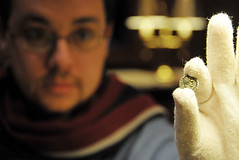 In 70 C.E., Roman Emperor Vespasian and his son, Titus, sacked the city of Jerusalem, destroying the Jewish temple.
In 70 C.E., Roman Emperor Vespasian and his son, Titus, sacked the city of Jerusalem, destroying the Jewish temple.
To commemorate the success of quelling the Jewish Revolt, the Romans minted a series of nearly 50 "Judea Capta" (Captured Judaea) coins in gold, bronze and silver to remind the Roman Empire of its victory. Most of these coins depict a Roman soldier or leader, outfitted in military attire, and a mourning female Jewish woman, seated under a palm tree or trophy.
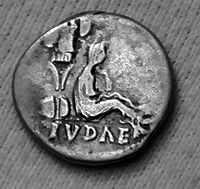 On Jan. 14, Jewish Chaplain Rabbi David Teva Leipziger Teva, director of religious and spiritual life, donated a silver coin, known as a denarius, to Wesleyan's Special Collections and Archives. The silver denarius, featuring an embossed profile of Emperor Vespasian and the words "Caesar Vespasianus Avg(ustus)," was struck in 69-70 A.D.
On Jan. 14, Jewish Chaplain Rabbi David Teva Leipziger Teva, director of religious and spiritual life, donated a silver coin, known as a denarius, to Wesleyan's Special Collections and Archives. The silver denarius, featuring an embossed profile of Emperor Vespasian and the words "Caesar Vespasianus Avg(ustus)," was struck in 69-70 A.D.
"The coin was probably minted at a time when the teaching of Judaism and outward expressions of biblical, temple cult-based Judaism were made impossible by a dominating power," Rabbi Leipzinger Teva says. "Fast forward to 2010 at Wesleyan. Today we have multiple creative pathways for students to express and explore their Judaism and their Jewish identities. This coin talked about the complete opposite of all of this."
Suzy Taraba, university archivist and head of Special Collections and Archives, says the denarius is the first coin donated to Wesleyan in at least 12 years. The coin will be housed with another Roman coin of the 15th century, which is embossed with the first, regularly used printer's mark. Taraba encourages faculty teaching courses on religion or history to use the coins as teaching tools.
To read the complete article, see: Jewish Community Donates Roman Coin to Special Collections (newsletter.blogs.wesleyan.edu/2010/01/19/jewish-community-donates-roman-coin-to-special-collections/)
1910 CELTIC FOOTBALL CLUB MEDAL DISCUSSED ON TV ANTIQUE SHOW
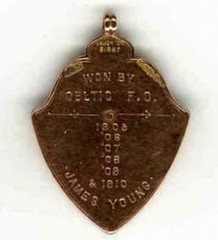 It's not every day you find out you're in possession of a valuable antique, but that's what Sam Taylor from Saltcoats was told, after Anita Manning took a look at a photograph of a very rare football medal of his.
It's not every day you find out you're in possession of a valuable antique, but that's what Sam Taylor from Saltcoats was told, after Anita Manning took a look at a photograph of a very rare football medal of his.
The Celtic presentation medal in the picture was awarded to James Young in 1910, to commemorate Celtic winning the League Championship six years in a row, and is a real collector's item, giving it a high value.
"Football memorabilia is greatly sought after, particularly the rarer pieces," Anita explained. "In auction I would put a conservative estimate, now it's conservative, at between £1000 and £2000. In auction this would be fiercely sought after, so I could see it doing even higher. This is a rare and wonderful item."
To read the complete article, see:
Antiques expert examines rare football medal that could make a mint
(living.stv.tv/home-garden/antiques/151997-anitques
-expert-examines-rare-football-medal-that-could-make-a-mint/)
S.S. CENTRAL AMERICA "SHIP OF GOLD" EXHIBIT RETURNS
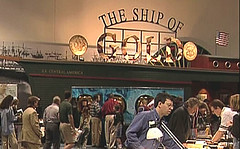
A decade after its first appearance, the precedent-setting "Ship of Gold" display showcasing California Gold Rush-era sunken treasure recovered from the 1857 shipwreck of the SS Central America again will dock in Long Beach, California.
The $10 million exhibit will be publicly displayed during the Long Beach Coin, Stamp & Collectibles Expo in the Long Beach Convention Center, 100 S. Pine Ave., February 4 – 6, 2010.
The exhibit is courtesy of Monaco Rare Coins of Newport Beach and involved months of work to coordinate the display with collectors who privately own and now have generously loaned many of the items for the exhibit, according to Adam Crum, Monaco Vice President.
"The ‘cargo' on display will be examples of historic assayers' ingots as well as San Francisco Mint and California territorial gold coins with a combined value today of over $10 million. One of the highlights is a huge, 662.28 ounce Kellogg & Humbert ingot.
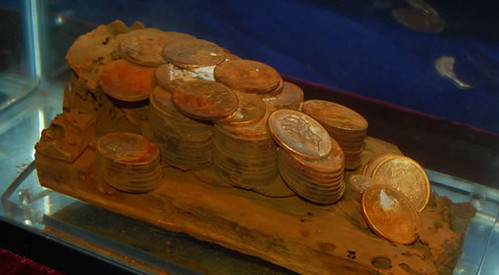
Weighing just over 55 troy pounds, it is the fourth largest gold bar recovered from nearly 8,000 feet blow the surface of the Atlantic Ocean where the Central America sank in a hurricane in September 1857 while carrying California gold from Panama to New York City," said Crum.
 Bob Evans, the chief scientist on the 1980's mission by the Columbus-America Discovery Group that located and recovered the fabulous sunken treasure, will be at the Long Beach Expo display each day to meet with visitors and present educational programs about the SS Central America, her cargo, crew and passengers.
Bob Evans, the chief scientist on the 1980's mission by the Columbus-America Discovery Group that located and recovered the fabulous sunken treasure, will be at the Long Beach Expo display each day to meet with visitors and present educational programs about the SS Central America, her cargo, crew and passengers.
To read the complete article, see: Historic "Ship of Gold" Returns to Long Beach Expo (http://www.coinnews.net/2010/01/18/historic-ship-of-gold-returns-to-long-beach-expo/)
SUPER BOWL COIN TOSS TO USE NASA SPACE VETERAN MEDAL
The crew of the space shuttle Atlantis' STS-129 mission will deliver a specially minted silver medallion to National Football League officials at 10 a.m. EST on Wednesday, Jan. 27, at the Pro Football Hall of Fame in Canton, Ohio. The medallion will be used for the official coin toss prior to the kickoff of Super Bowl XLIV on Sunday, Feb. 7.
Shuttle commander Charlie Hobaugh, a graduate of North Ridgeville High School near Cleveland, Pilot Barry Wilmore, Mission Specialists Leland Melvin, Randy Bresnik, Bobby Satcher and Mike Foreman, from Wadsworth, Ohio, returned from their 11-day space mission to the International Space Station on Nov. 27.
To read the complete NASA press release, see: NASA Astronauts Presenting Special 'Space Veteran' Super Bowl Coin (http://www.nasa.gov/home/hqnews/2010/jan/HQ_M10-013_Super_Bowl_Coin.html)
FEATURED WEB PAGE: J. S. BACH MEDALS, MEDALLIONS & COINS
This week's Featured Web page is suggested by Dick Johnson. He writes:
It's on Bach coins and medals (with one piece of paper money that snuck in as well).
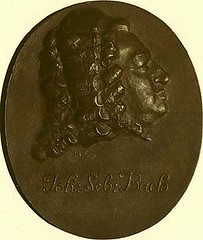
www.bach-cantatas.com/Memo/R-Medal.htm

